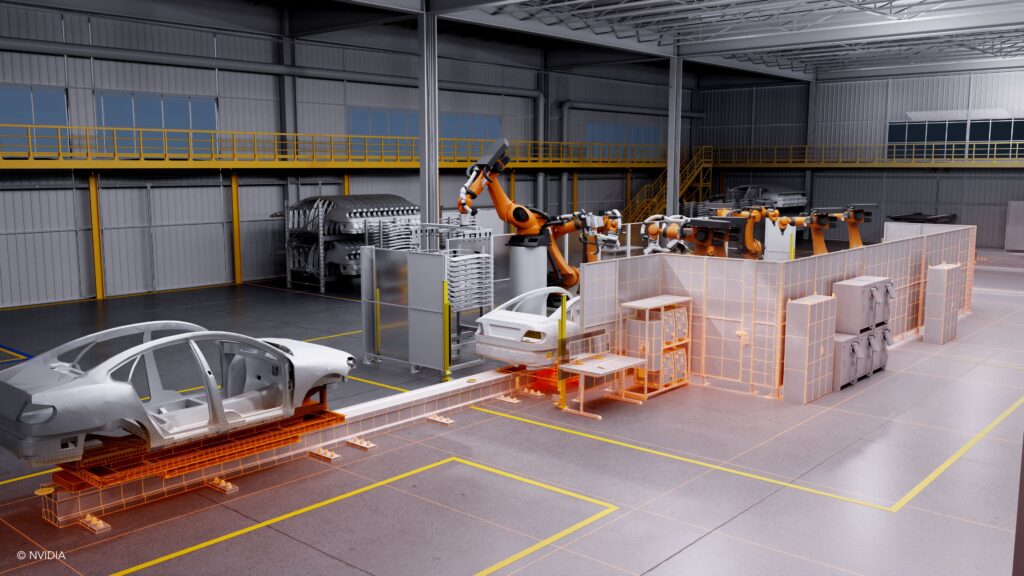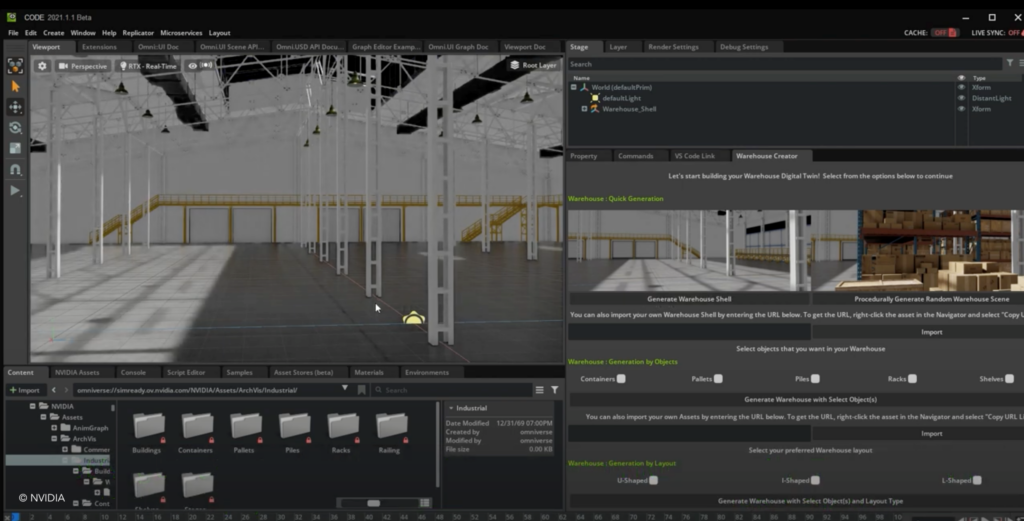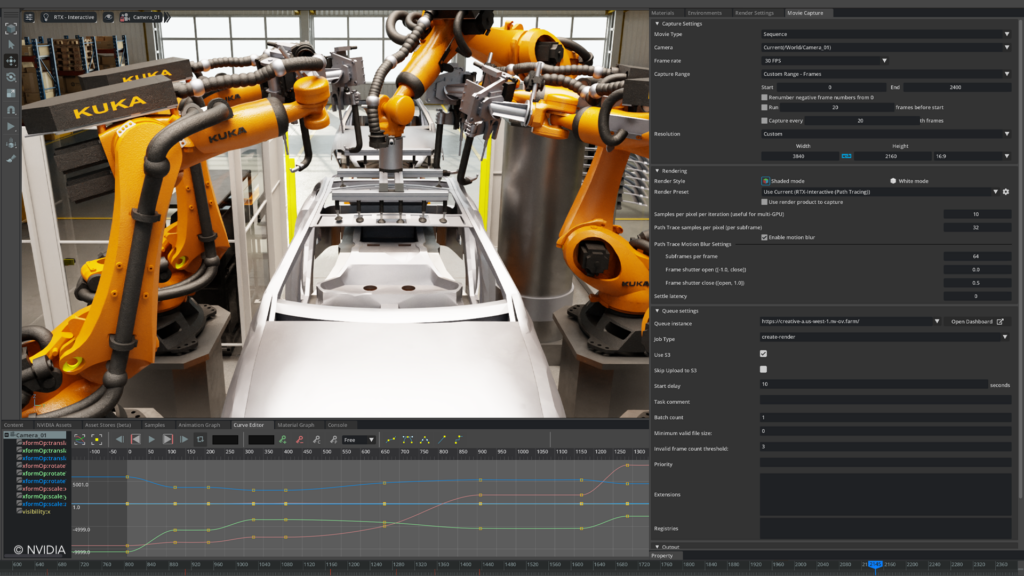
In the latest edition of the “Meet the Visionary” series, we explore the world of Universal Scene Description (OpenUSD) through the lens of Rev Lebaredian, Vice President of Omniverse and Simulation Technology at NVIDIA. Rev’s insights and innovations are shaping the future of AI-enabled virtual worlds and the OpenUSD ecosystem. 
NVIDIA: Enabling OpenUSD Adoption
At NVIDIA, Rev leads product and engineering for NVIDIA Omniverse, a platform for developing OpenUSD-based applications and microservices for industrial digitalization and generative physical AI. “Everything I’ve been doing for the last seven years has been built and focused around OpenUSD,” Rev explains, highlighting the central role of this technology at NVIDIA.
The journey began in 2016 when NVIDIA recognized the need for a unified way to represent and integrate 3D data for simulations in various domains, from autonomous vehicles to robotics. “We started Omniverse to build a simulation toolkit to train and test perception AI models,” Rev recounts. “The first problem to solve was integrating world-scale data whether city, warehouse, or factory.”
When they started using USD, which Pixar had open sourced, Rev and his team saw its potential immediately. “We thought it looked like the best thing out there to achieve our goal,” he says. “It could be grown into what was needed, so we went all in from the start.”
 Through Omniverse, built on OpenUSD, NVIDIA has become a pioneer in driving adoption of the 3D framework across industries, by enabling developers to build AI-enabled apps and workflows.
Through Omniverse, built on OpenUSD, NVIDIA has become a pioneer in driving adoption of the 3D framework across industries, by enabling developers to build AI-enabled apps and workflows.
 A Vision for Open Standards in 3D
A Vision for Open Standards in 3D
Rev’s enthusiasm for OpenUSD stems from both its technical capabilities and its open nature. Drawing parallels to the early days of the web, he argues that the open nature of OpenUSD is crucial for its widespread adoption and continued evolution.
“USD was different,” Rev explains, comparing it to previous attempts at creating 3D interchange formats. “I’ve been involved in computer graphics since the mid-80s, and I’ve seen many attempts to create a standard for 3D data exchange fail,” Rev recalls. “USD on the other hand was well thought-out, open from the start, and solved many problems that previous formats couldn’t.”
One of the key features that sets OpenUSD apart, according to Rev, is its composition engine. “OpenUSD is not just a format — it’s also this composition engine that’s open and extensible,” says Rev. “There’s an engine to compose everything into one big world and to do so in such a way that many people can work on all the different parts without stepping on each other’s toes.”
This capability enables unprecedented collaboration and innovation in 3D content creation, opening up new possibilities for industries ranging from film and gaming to robotics, industrial design, and engineering.
 Building a Global OpenUSD Community
Building a Global OpenUSD Community
Under Rev’s leadership, NVIDIA has become a driving force in the advancement and adoption of OpenUSD among developers. The company has not only based key technology offerings — most notably its Omniverse development platform — on USD but has also co-founded and been actively contributing to the Alliance for OpenUSD (AOUSD) to evangelize its benefits across industries.
“We’ve been thrilled by how far USD has come,” Rev says, reflecting on the journey since 2017. “We sparked something, and you can see from all the interest in AOUSD and who’s joining, we tapped into something important.”
Rev and the NVIDIA team are deeply committed to enabling the OpenUSD ecosystem, collaborating with partners who are building highly accurate, AI-enabled virtual worlds and the tools that will make these worlds possible.
NVIDIA and Ansys have expanded their long-standing partnership to include new opportunities in AI and accelerate a new era of digital engineering. To enable 3D visualizations of simulation results for their users, Ansys uses NVIDIA Omniverse to easily integrate OpenUSD and NVIDIA RTX rendering technologies into existing software tools and simulation workflows.
Additionally, NVIDIA and Siemens just announced that they’re extending their collaboration to facilitate more industrial workloads using OpenUSD. Siemens, a global leader in industrial automation and software, is building on their efforts to incorporate Omniverse into its Teamcenter Product Lifecycle Management portfolio. Siemens will now also integrate OpenUSD pipelines into its Simcenter portfolio, enabling simulation use cases to support real-world operating environments.
At NVIDIA, Rev’s team has worked to foster a community and support system for OpenUSD users across the ecosystem. Through livestreams, forums, and dedicated resources, NVIDIA enables developers to ask questions and get answers on their most pressing workflow queries. Rev notes, “We contribute to the open source community, help develop standards, and provide free educational materials to promote OpenUSD.”
Rev himself is a passionate advocate for OpenUSD, regularly engaging with industry leaders to promote its benefits. His efforts have helped bring OpenUSD to the forefront of discussions in various sectors, highlighting its potential to transform digital workflows and data management.
 Envisioning the Future of OpenUSD
Envisioning the Future of OpenUSD
While OpenUSD has come a long way, Rev sees this as just the beginning. He envisions a future where OpenUSD evolves with exciting prospects like proceduralism. This addition would enable dynamic, interactive elements within USD-based environments, akin to JavaScript’s impact on web interactivity.
“The next challenge is integrating procedures realistically into USD,” he explains. This advancement promises interactive 3D content, transforming USD assets into fully interactive entities for simulations, digital twins, and diverse 3D experiences across industries. Rev emphasizes the need for collaborative innovation, drawing parallels to HTML’s development and the evolution of web interactivity.
Rev is also focused on the advancements that NVIDIA can contribute now to drive OpenUSD adoption. This week at SIGGRAPH, NVIDIA announced that the world’s first generative AI models for OpenUSD development will be available as NVIDIA NIM microservices.
“Until recently, digital worlds have been primarily used by creative industries,” explains Rev. “Now, with the enhancements and accessibility NVIDIA NIM microservices are bringing to OpenUSD, industries of all kinds can build physically based virtual worlds and digital twins to drive innovation while preparing for the next wave of AI: robotics.”
Learn more about Rev’s perspectives on the connection between computer graphics, physical AIs, and virtual worlds in his recent LinkedIn article.
 A Global Vision for 3D Standards
A Global Vision for 3D Standards
Rev’s advocacy for OpenUSD extends beyond the tech industry. He sees OpenUSD as a crucial component in building a unified digital ecosystem that spans industries and geographies. This vision of OpenUSD as a fundamental technology for the future of digital representation and interaction drives Rev’s work at NVIDIA and his contributions to the broader community.
As we continue our “Meet the Visionary” series, Rev’s insights offer a compelling glimpse into the future of 3D content creation and virtual worlds. His leadership at NVIDIA and his visionary work with OpenUSD are paving the way for transformative changes across industries, underscoring the potential for OpenUSD to revolutionize how we create, manage, and interact with digital content.
If your company is interested in joining the Alliance for OpenUSD, sign up to become a member. Follow AOUSD on Facebook, Instagram, LinkedIn, X, and YouTube, and get support from our community of artists, designers, and developers in our forum.
See how to build AI-enabled 3D pipelines and tools using OpenUSD in engaging sessions, hands-on labs, and a developer meetup hosted by NVIDIA at SIGGRAPH, July 28 – August 1.
